Abstract
The present review gives a brief report on the Morphological, phytochemical and Pharmacological properties of Amaranthus Tricolour along with highlighted information (ethnopharmacology i.e traditional medicinal uses) and Studies from phytochemistry to Pharmacology and Clinical practice.The Application of Amaranthus tricolor in therapeutic pharmaceutics and cosmetics. industries Its various pharmacological actions provide this plant have a bright future for medicinal use with Skin disorders (eczema and psoriasis) as well as respiratory problems and it shows various pharmacological activities like Anti-Alzheimer activity, Antiarthritic. activity, Anti-bacterial activity, Antiprotozoal activity, Inflammatory activity, Antioxidant activity, Antimalarial activity, Analgesic activity, Immunomodulatory activity, Hematology activity, Hepatoprotective activity, Antifertility activity, Antidiabetic, anti-hyper lipidemic spermatogenic effects, Toxicities, Gastric antisecretory and cyto-protective. activity, cardioprotective activity.Amaranthus tricolor has many common names including: - Chinese spinach, tumpala, caullado, bireum, tandaljo, Tandauljabhaji such studies concluded that this plant possesses over. 20 active Chemical constituents like betalalins, hydroxycinnamates, saponins, steroids and flavonoids as the major additives and it will being the key contributors.
Keywords
Traditional medicine, Amaranthus tricolor, phytoconstituent, Pharmacological activity, toxicity.
Introduction
Herbal medicine has its origins in ancient cultures. It involves the medicinal use of plants to treat disease and enhance general health and wellbeing. They are often considered safer than pharmaceuticals, with fewer side effects.it focuses on treating the whole person, not just the symptoms. Many people prefer traditional remedies due to cultural or family ties. Traditional remedies increases when conventional medicine is ineffective in the treatment of disease. The Amaranth, derived from the Greek word (amárantos) and meaning "unfading", refers to a group of Plants known for their long-lasting flowers. A notable species, amaranth tricolor, contains vibrant purple and red colours and is commonly eaten in India, particularly In Jharkhand and West Bengal. This plant thrives in tropical regions, including South Africa, Sri Lanka, Southeast Asia, and Central and South America. Amaranth is Increasingly recognized as valuable crop throughout the world, especially in Africa, where different species are grown as It's growing pseudo-cereals and vegetables. It's is attributed to its resistance popularity is to heat and diseases, along with its high nutritional content. The leaves of Amaranthus are rich in Protein and micro nutrients. Such as calcium, iron and vitamin A and C [1].Furthermore, Herbal remedies derived from these plants are important in healthcare Especially in developing regions. where ancient texts highlight a wide array of medicinal Plants utilized for various ailments. All Parts of the plant considered potential source of medicinal substance [2] The main challenge in the acceptance of herbal medicine is it lacks of quality control and standardization, making efforts toward these aspects extremely important [3]western species of Amaranthus often Consumed as spinach are regarded as nutritionally. comparable if not superior as other leafy vegetables the species is found to be grown in Bernie, Nigeria, Kenya, Tanzania and Southern Africa and throughout India [4]Ethnologically the herb is used as a purifier tonic in dropsy as ascaricide in toothache, sore throat, cough and bronchitis.The roots, leaves and stems are eaten in case of bilious disorders and used as an appetizer. The roots, leaves and stems are used in ease used in lucorrhoea, important against colic, gonorrhea, enzymes and have galactogenic properties. A decoction of the roots with cucurhita pepo linn is used to control bleeding after abortion [5]. Amaranthus tricolor linn is commonly known as choulai in Hindi Joseph's clothing is known to pass good medicinal value in the traditional medicine system. The Juice of A. spinous is used by the tribes of Kerala, India to prevent bumping around the stomach, while the leaves are boiled without salt and consumed for 2 to 3 days to cure jaundice [6]. The plant as one of the vegetables has a high concentration of antioxidant compounds and high nutritional Values. Due to the presence of Fiber, Protein and high concentration of essential amino acids, especially lysine [7]. Amaranth (Amaranthus spp.) a plant related to spinach was a staple food for Inca, Mayer, and Aztec culture. It has generated the monikers of Rajgira (the grain of king). The taste Project highlights the nutritional benefits of various good items that are rich in protein lysin and threonine gradually replacing convential ingredients in baked goods. Research has explored the balance of these nutrients in whole grain bread, emphasizing their importance. The deficiency in protein-rich ingredient has prompted the inclusion of diverse Species like Amaranth. which is becoming a staple in everyday diets various types of Amaranthus, including A: Hypochondriaces. A. cruentus, and A. edules can be easily incorporated into salads and soups. Amaranthus varieties are also recognized for Their potential use in stock feed. showcasing their versatility and nutritional value [8]. During the Twentieth century. The increase in life expectancy highlighted Alzheimer's disease (AD): as a significant public health concern AD is the most common Progressive Neuro degerative disorder characterised by a high complex Pathogenesis disorder incidence, and it is a polygenic involving protein. misfolding and neurodegeneration [9]. AD is marked by the accumulation of insoluble amyloid Beta-plaques Neuro Fibrillary tangle cognitive deflicts. The pathology of AD remains poorly understood as it is believed to be influenced by both genetic and environmental factor Numerous studies have shown that central Cholinergic neurons play a crucial role in learning and memory with aging there is decline in cholinergic function which is linked to memory impairment. ultimately understanding these mechanisms is essential for developing effective treatment [10]. Alzheimer's Disease (AD) is a neuro degenerative disorder that Progresses with age, causing Significant loss of cognition, and. impacting more than 35 million people worldwide Approximately 60% of instances are attributable to AD [11]. There is currently no effective treatment available, with current therapies, Involving the use of Acetylcholinesterase inhibitors such as taurine, physostigmine, and donepezil, but overuse can lead to adverse effects [12]
1.2. Botanical Description and Pharmacological Profile
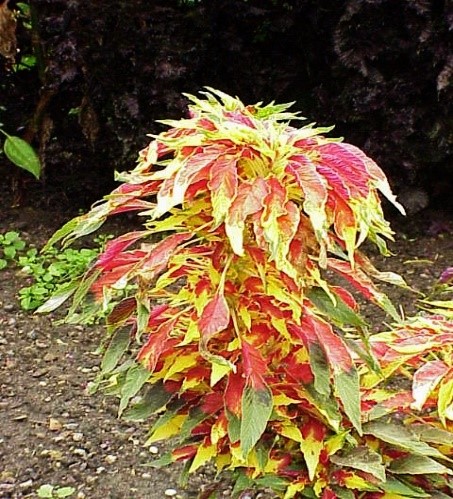
Fig 1.2.1: - Whole Plant of Amaranthus tricolor [13]
Synonym: - A gangeticus linn, A-Melancholicus linn, A. Polygamous linn, F.A. Tristis linn.
Family: - Amaranthaceae
Common Vernacular Names
Sanskrit: - marisarkakta, aramasitalika
Bangla: - lal shak
English: - chinese spinach
Ayurvedic: - maurisha - rakta [var]
Siddha/Tamil: - Arai-Keerai.
Folk: - laal shak, laal marasha
Gujarati: -Tandoljo [lal].
Hindi: - lal marsa
Kannnad: - banto, harave Sappe.
Malayalam: -Arama setatalum
Marathi: - mash, rajgira, ranbhaji.
Punjabi: - lal marsa sug
Tamil: - mulaikkeerai
Telgu: -Erra tutakara
Taxonomy: -
Domain: - Eukaryota
kingdom: - Plantae
Subkingdom: -viridaeplantea
Phylum: -Tracheophyta
Sub Phylum: - Euphyllophytina
infra-Phylum: - Radiotopses
Class: - spermatopsida
Subclass: - curyophylidae
Super order: - caryophyllanae
Order: - Chenopodiineae
Family: - Amaranthacea
Subfamily: - Amaranthoideae.
Tribe: - Amaranthea
Genus: - Amaranthus
Specific Epitheli: - Tricolor.
2. Images of Parts of Amaranthus Tricolor
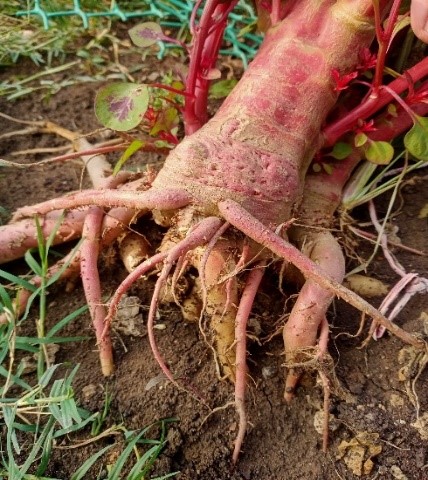
Fig 2.1: - Roots of Amaranthus Tricolor
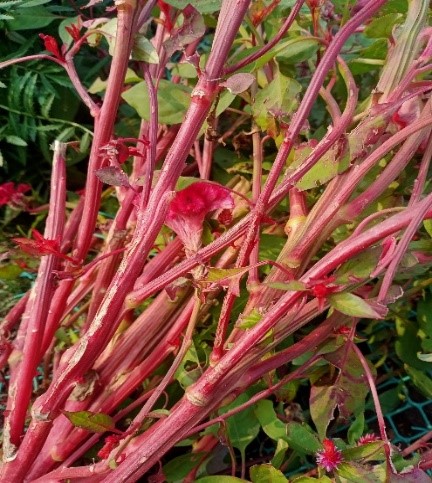
Fig 2.2: - Stem of Amaranthus Tricolor
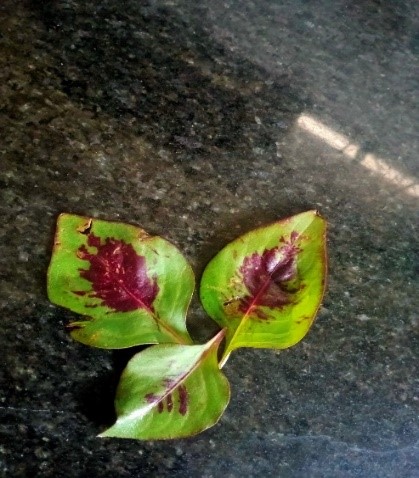
Fig 2.3: - Leaves of Amaranthus Tricolor
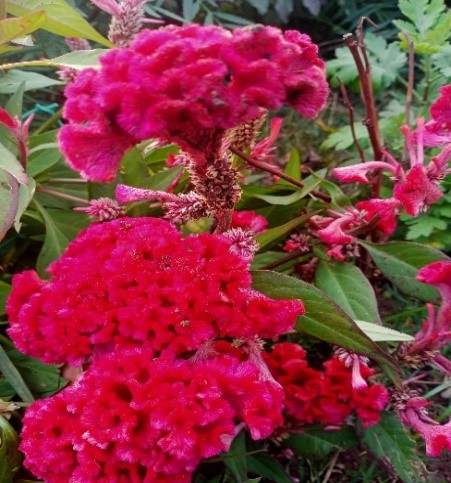
Fig 2.4: - Flowers of Amaranthus Tricolor
3.Chemical Constituents
The tricolor plant Amaranthus has many Chemical compounds that exhibit different biological activities. Betaline pigments are betacyclin and betaxanthin are the main pigments present in Amaranthus tricolor and the glycosylated flavonoids Calmo glycol acid quercetin.
A tricolor leaf has pigments such as chlorophyll a (ch/ab) corotenoid (tn). Betacinine [eg .betanin] Betaxanthin (B) and the total phenolic content:- hydro benzoic acid gualic acid (3,4,5-trihydroxy benzoic acid) vanillic acid (4-hydroxydimethoxybenzoic acid, p-hydroxy benzoic acid (4 hydroxybenzoic acid) Salicylic acid (2 hydroxybenzoic) ellagic acid (2,3), 78-tetrahdroxychromic [5,4,3 dichromene-5-10-dione], benzoic acid Hydroxycinnamic acid-caffeic acid [3,4hydroxycinnamic acid-caffeic acid ] Flavonoids-isoquercitrin [quercitin-3-glucoside] Rutin (quercitin-3-rutinosic) isorhametin, kaempferol quercitin.
Betalins are ammonium derivatives of betamic acid 4-2-oxoethylidine. 1,2,3,4- tetrahydroxypyridine-2[6-dicarboxylic acid]
The plant is known for its betalin purple pigment such as, Amaranthus and isoamaranthine Amaranthus had calcium, iron, magnesium, potassium, zinc, proteins, vitamin C and A. Fatty acid and sterols are present in amaranth tricolor flax. The major polyunsaturated fatty acid found in seeds, Stem and leaves. were palmitic acid, linoleic acid, and urachidic acid present in internal quantities and 24-methylglencytol was found in the Seeds
4.Traditional Uses of Amaranthus Tricolor: -
Amaranthus Tricolor has been used in various traditional medicine system including: -
A] The whole plant of Amaranthus Tricolor is traditionally used as an astringent and it acquire hepatoprotective activity. [14]
B] Amaranthus Tricolor Linn is one of the traditional medicines used in many folks swears and the plant has been utterly used in ayurveda and siddha for curing diarrhoea, cough and bronchitis.
C] It is used as an emollient or mouthwash to manage ulcerative condition of throat and oral cavity [15]
D] This plant is used for variety of treatments like gonorrhoea, leucorrhoea and piles [16]
E] In Bangladesh to the entire plant is used for a range of therapeutic purpose including anemia, skin disease diabetes and blood purifier [17]
F] The decoction of plant is taken, and it is used internally to strengthen the liver and improve vision and traditionally root paste mixed with warm water and it given in the time of vomiting and remove out toxic matter from bowel, and root paste in combination with honey and rice water is useful in leucorrhoea. [18]
G] The leaves and young stem is used as salad and cooked as a leafy vegetable scientific study on the plant suggests that it is used to inhibit calcium retention. [19]
H] In traditional chinese medicine system it is used to treat digestive problem diarrhoea and fever.
I] In African traditional medicine system, it is used to treat various aliments like malaria, diarrhoea and skin conditions
5. Pharmacological Reported Activities: -
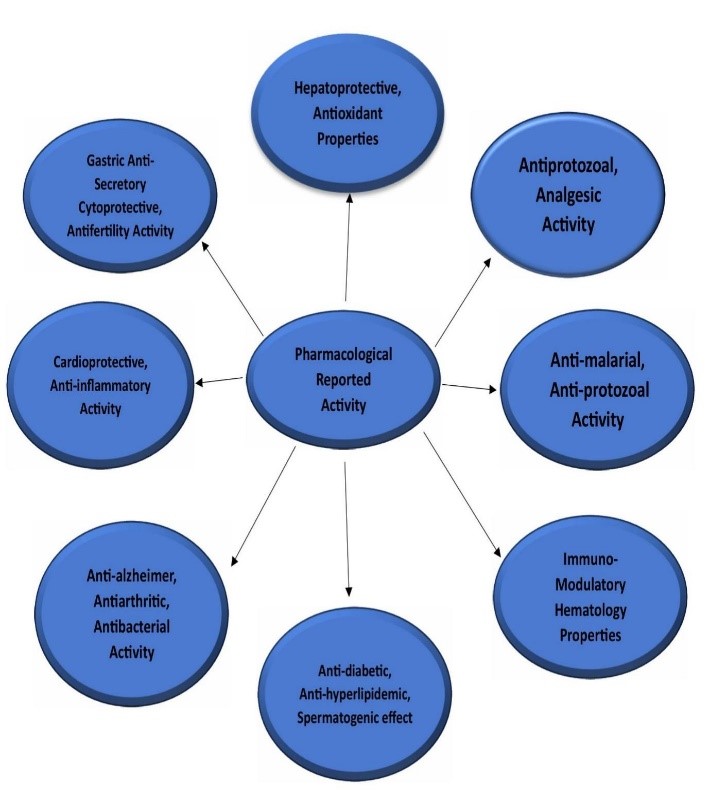
5.1. Anti-Alzheimer Activity [12] [10]: -
Alzheimer's disease elevates concerns as it is a global health issue. AD is a neurodegenerative disease that encompasses a variety of characteristics, which involve the deposition of amyloid- beta plaques, the presence of neurofibrillary tangles, and the reduction of cholinergic neurons. There is a large variety of proteins and pathways involved in the progression of the condition which suggests a complex and unknown cause to the disease. This disorder has several risk factors, one of the prime such factors being Advanced Age, but it is further through genetic basis and environmental interactivity as well. There is also evidence that supports the role of the patient’s central cholinergic neurons in the processes involved in learning, attention, and memory. Due to progression in age, the patients experience gradual modification of the cholinergic system that results in loss of the ability to absorb new information. The prevalence of AD has increased; about 60% of diagnosed dementia is attributable to AD which has over 35 million cases are diagnosed, and around seven million new cases every year. For AD treatment, there are several mechanisms that can be potentially altered, which include targeting the others mechanisms understanding which may prevent the realization of amyloid- beta, restore neurotransmission in cholinergic neurons, alleviate neuroinflammation, and so on. Many studies are underway regarding the pharmacological treatment as well as the lifestyle changes that could potentially provide the patients with enhancement of their cognition.
5.2. Antiarthritic Activity [20]
The evaluate the antiarthritic activity of the hydroalcoholic extract of Amaranthus tricolour in female wistar rats. HAET was prepared by maceration and underwent a preliminary phytochemical examination and tested against FCA- induced arthritis in the rat. the arthritis evaluation was performed by measuring the leg volume; joint diameter, body weight, arthritis score, pain threshold thermal hyperalgesia, hematological and biochemical parameter.
5.3. Antibacterial Activity [21]
Urinary tract infection is most common bacterial infection. The study is done for the evaluation of the antibacterial activity of the amaranto extract of amaranto and to determine the clinical characteristics of the infections of the Antibacterial activity
In this investigate facility, the hoja amaranthus tricolor remove was organized by macerating it in tricon methanol. The early desire of change is based on the revelation of carbohydrates, proteins, steroids, alkaloids, glycosides, flavonoids, and tannins. This asks almost centers on staphylococcus, faecalis, Escheriella pneumonia, and proteusvalgaris are commonly utilized.
5.4. Antiprotozoal Activity [22]
The dichloromethane extract of A. spinosus (2 mg/mL) was moderately inhibited to Blastocystis hominis, an ordinary human protozoan. The Testimonial anti protozoan agent, metronidazole (40 µg/mL) eliminated 97% of the protozoan and hesitant all protozoan samples at concentrations of 1.25-20 µg/Ml
5.5. Anti-Inflammatory Activity [23]
The anti-inflammatory property of methanolic extricate of A. spinosus takes off was considered in diverse creature models. A. spinosus extricate (25-100 mg/kg) essentially restrained carrageenan- induced rodent paw edema and created critical restraint of acidic acid-induced increment in vascular penetrability demonstrating that the extricate has anti-inflammatory action. In the cotton pellet granuloma test, rats were treated orally with the extricate for 4 continuous days after the subcutaneous implantation of a sterile pellet. The highest dose of the extract (100 mg/kg) was able to remarkably reduce the post-implantation weight of cotton pellets in contrast to controls indicating its efficacy against acute inflammation.
5.6. Antioxidant Properties [24]
The summary of the text demonstrates the antioxidant ability of A. spinosus in the air pollution milieu, particularly nitrogen oxides and sulfur dioxide. As further indicated, other antioxidant enzymes exhibited good activity in A. spinosus, thereby allowing for the plant to persist in its habitat. The key enzymes investigated were superoxide dismutase, catalase, ascorbate peroxidase, glutathione reductase, and phenolic peroxidase. The presence of betalain pigments in Amaranthaceae plants, including A. spinosus, has a direct link to their antioxidant properties, as the evidence is affirmed through the results of the DPPH assay showing EC50 values between 3.4 and 8.4 µM. These results evidently indicate that the antioxidant activity could actually be due to the right betalain component, which is effectively linked with free radical scavenging and therefore the amelioration of oxidative stress resulted from environmental pollutants.
5.7. Anti-Malarial Activity [24]
I] The antimalarial properties of the watery extricate of develop A. spinosus bark were tried in mice with Plasmodium berghei-infected erythrocytes. The bark extricates shown antimalarial action that expanded with measurement in a 4-day suppressive antimalarial test with chloroquine as the standard sedate. The extricate and chloroquine appeared to have ED50 values of 789.4 and 14.6 mg/kg for their antimalarial exercises, individually.
II] the extricates from two plants utilized in conventional Burkinabe pharmaceutical, spiked amaranth, were tried for their antimalarial properties to affirm their viability as cures. The plant extricates illustrated striking antimalarial impacts in the 4-day suppressive antimalarial test in mice contaminated with Amaranthus spinosus was decided to be 789 and 564 mg/kg. Furthermore, the examined plant material demonstrated minimal toxicity with an LD50 of 1450 mg/kg for Amaranthus spinosus.
5.8. Analgesic Activity [23]
The methanolic extricate from A. spinosus clears out a slow diminish in acidic corrosive actuated writhing at measurements extending from 25-100 mg/kg. The most noteworthy dosage come about in a 56.2% diminish in writhing). these extract doses also decreased the time spent licking at the last stage (20 minutes after formalin injection), but did not affect the early stage of the formalin- induced paw licking test in mice.
5.9. Immuno-Modulatory Properties [25]
The aqueous extract of A. spinosus leaves appeared to have immuno-modulatory impacts by altogether fortifying splenocyte expansion in essential splenocytes from female BALB/c mice. The extricates (1250 µg/mL) evoked a much higher expansion rate in bulk splenocytes than in confined decontaminated B and T cells, recommending a few sorts of interaction between these cells. In this way, the immunostimulant impacts of the water extricate may lead to T lymphocyte expansion. A novel immuno-stimulatory protein (GF1) with an atomic weight of 313 kDa was obtained after successive refinement of the water extricate. GF1, which was accepted to be a glycoprotein and was warm labile, had an immunostimulatory movement which was 309 times higher than that of the water extricate
5.10. Haematology Properties [26]
Ethanol extricate of Amaranthus spinosus leaf (EEAL) was managed orally to developing pigs to decide its impacts on the hematological characteristics-packed cell volume (PCV) ruddy blood cell (RBC) and white blood cell (WBC) tallies, and haemoglobin (HB) concentration. Eighteen developing pigs were arbitrarily designated to two medications with each treatment reproduced three times. Pigs in treatment 1 were superintended with EEAL. Treatment 2 served as control receiving no treatment. exhibits shows that there was significant (P<0>
5.11. Hepatoprotective Activity [27]
The hepatoprotective and antioxidant movement of 50% ethanolic extricate of entirety plant of Amaranthus spinosus (ASE) was assessed against carbon tetrachloride (CCl4) initiated hepatic harm in rats. The ASE at measurements of 100, 200 and 400 mg/kg were managed orally once every day for fourteen days. The considerably hoisted serum enzymatic levels of serum glutamate oxaloacetate transaminase (AST), serum glutamate pyruvate transaminase (ALT), serum soluble phosphatase (SALP) and add up to bilirubin were reestablished towards normalization essentially by the ASE in a measurement’s subordinate way. Higher dosage shown critical hepatoprotective movement against carbon tetrachloride-initiated hepatotoxicity in rats. The biochemical perceptions were supplemented with histopathological examination of rodent liver areas. In the meantime, in vivo antioxidant exercises as malondialdehyde (MDA), hydroperoxides, decreased glutathione (GSH), superoxide dismutase (Grass) and catalase (CAT) were moreover screened which were moreover found altogether positive in a dosage subordinate way. The result of this ponders emphatically demonstrate that all plants of A. spinosus have powerful hepatoprotective movement against carbon tetrachloride initiated hepatic harm in exploratory creatures. This ponder recommends that conceivable component of this movement may be due to the nearness of flavonoids and phenolics compound in the ASE which may be dependable to hepatoprotective action.
5.12. Antifertility Activity [28]
The Anti-fertility screening after ingestion of fluid and ethanolic extricates of Amaranthus spinosus Linn roots have been explored in pregnant rats. The ingestion of 125, 150 and 175 mg/kg body weight of alcoholic extricates of the plant from day one to day five of pregnancy by female rats did cause noteworthy pregnancy capture attempts. On other hand the ingestion of 125mg/kg body weight of fluid and alcoholic extricates of plant from day 11 to day 15 of pregnancy did not cause noteworthy pregnancy interferences. However, the uptake of 150 and 175 mg/kg body weight of alcoholic extracts of plant drugs exhibited notable pregnancy interceptory affect. The alcoholic extracts of selected ethno medicinal plants possessing more pregnancy seizing than aqueous extracts.
5.13. Anti-diabetic, anti-hyperlipidemic spermatogenic effects [29]
The methanolic extract of stem of Amaranthus spinosus Linn (Family: Amaranthaceae) in diabetic rats. In streptozotocin (STZ)-induced diabetic rats, it was perceived that both the standard drug (Glibenclamide) and methanolic extract of Amaranthus spinosus Linn. Remarkably exhibited control of blood sugar level on a 15day model. Further, the methanolic extract also showed exception against lipoidemia and spermatogenic outcome in STZ-induced diabetic rats. The methanolic extract has also escalated the process of spermatogenesis by intensifying the sperm count and accessory sex organ weights. The present assessment of the plant established some pharmacological evidence to support the folklore assert that it is used as an antidiabetic.
5.14. Toxicities [30] [31]
The aqueous extract of the bark of A. spinosus has a corresponding low toxicity LD50 value of 1450 mg/kg A. spinosus was reportedly the offender in cases of spontaneous poisoning of livestock in Brazil during a drastic drought. Clinical signals appeared after 30 days in 11 out of 35 matured cows and 8 out of 20 yearling calves which were instigated into a 15-ha maize plantation heavily infested with A. spinosus. However, only one calf died within 3 -7 days. The clinical signs were depression, starvation, marked weight loss, offensively malodourous diarrhea occasionally tinged with blood, and subcutaneous oedema. Sub-acute cases showed distended abdomens, the animals were reluctant to stand and walked with difficulty. Sloughing of the hooves occurred in some animals. The main post-mortem detections in 5 animals were relatively pale and swollen kidneys, perirenal oedema and assorted degrees of oedema in various tissues and cavities. In some cases, petechiae and suffusions were correlated with the subcutaneous oedema. The mucosa of the digestive system showed necrotic glossitis, esophagitis and pharyngitis, abomasal hemorrhages and button-like ulcerations in the large intestine. The contents of ileum, colon and rectum were blood stained. Hemorrhagic diathesis was obvious by the existence of intra-abdominal hematomas. Microscopically, there was noticeable tubular nephrosis associated with epithelial rejuvenation and hyaline intra-tubular casts. The mucosal abrasions consisted of large necrotic areas in the epithelium which broaden into the lamina propria and were associated with inflammatory feedback with massive aggression of mastocytes. The omasal mucosa had discriminating necrosis of the basal layer cells. Renal failure was counseled as the primary lesion which triggered the other changes. A. spinosus also caused an outbreak of acute poisoning in ewes in Southern Brazil. The clinical signs were uremic halitosis, loss of ruminal migration, puffing and abortion. The kidneys appeared pale ruddy spots, white streaks amplifying from the cortex to medulla and clog There were extreme intense tubular nephrosis, scattered foci of coagulative corruption in the liver, regions of agglomerative corruption in the myocardium, and intense early interstitial pneumonia and supplementary bronchopneumonia minutely seen. Hyperkalemia auxiliary to renal inadequate was the fundamental cause of myocardial embolism necrosis found in seven sheep.
5.15. Gastric Antisecretory and Cytoprotective Activity [32]
The effect of leaf extract Amaranthus tricolor Linn. On gastric secretion and the effect of gastric cytoprotection were appraised using five different models of gastric ulcers: acetic acid-induced, pylorus ligation induced, ethanol-induced, indomethacin-induced and ischemiare perfusion- induced gastric ulcers.The different extracts, namely,ethanolic abstraction (EAT), petroleum ether abstraction (PEAT), chloroform abstraction (CAT) and ethyl acetate abstraction (EAAT). The EAT and EAAT showed gastric ulcer-healing effect in acetic acid-induced chronic gastric ulcers. The leaf extracts of A. tricolor are found to holds very good antiulcer characteristic in gatric ulcers which is harmonious with the liberal arts
5.16. Cardioprotective
A number of ponders illustrated that utilization of polyphenolic rich diet limits the incidence of coronary heart disease. Amaranth products, like defatted amaranth flour and protein concentrate have the ability to bind bile acids that has been hypothesized as a possible mechanism by which dietary fibers lowers blood cholesterol level [33]. Oral administration of dried A. Virdis whole plant altered C-reactive protein, total protein, albumin, globulin, ceruloplasmin and glycoprotein levels in serum and heart of isoproterenol-induced myocardial infracted rats. [34] It also lowered levels of serum enzymes (AST, ALT, LDH, CPK), cardiac troponin, GSSG and LPO of membrane and upraised levels of antioxidant enzymes (CAT, SOD, GPx, GST and GSH), bringing back all the parameters to near normal [35], exemplifying its cardioprotective effect. anti– atherosclerotic effect of ethanolic extract of A. caudatus L. on male New Zealand rabbits was studied by Kabiri and group. [36]On the 30th and 60th day of inquiry, rabbits fed with high lipid diet and A. caudatus extract had significantly decreased lipoprotein, LDL-C, triglyceride, oxidized LDL, apolipoprotein A &B, CRP, HDL-C and atherogenic indicator. The fatty streak formation evaluated on 60th day, showed appreciable decrease in lesion geviousness, establishing that A. caudatus extract was more effective than lovastatin. In an extended study, hydroalcoholic extracts of A. caudatus and Hypericum perforatum L. were investigated and found to possess significant anti-fatty streak effect in hyper-cholesterol emic rabbits [37]. Leaf extracts of A. spinosus singularly and in combination with vitamin C reversed unfavorable alterations (increased MDA but reduced GSH, CAT and SOD of heart) in adult rats on high fat diet [38]. Soares et al. [39]cited in their work, three novel peptides from grain of A. cruentus, that remarkably tampered HMG-CoA reductase, a key enzyme in cholesterol biogenesis; suggesting a possible hypocholesterolemic effect. Unprocessed and extruded amaranth hydrolysates (EAH) from A. hypochondriacus showed a reduction in the expression of interleukins involved in atherosclerosis in THP-1 lipopolysaccharide (LPS)-induced human macrophages. Also, EAH reduced the expression of LOX-1, ICAM-1 and MMP-9, important molecular markers in the atherosclerosis pathway [40]
CONCLUSION
Amaranth is an important traditional herb which has been used for years in the country's traditional medicine. In order for holistic well-being, current scientific opinion suggests consuming the whole plant instead of isolated compounds, such as in the case with nature supplements prepared with all synergistic phytonutrients. This Literature revealed that Amaranthus spinosus Scientifically reported for Antiprotozoal, Anti-inflammatory, Anti-malarial, Analgesic, Immunomodulatory, Haematology , Antifertility, Anti-diabetic, anti-hyperlipidemic and spermatogenic effects, , Gastric antisecretory , Cytoprotective and Cardioprotective activity. Traditionally it is utilized to avoid swelling around stomach, jaundice, remedy wounds. A. Spinosus has diverse active constituents like alkaloids, flavonoids, glycosides, phenolic acids, steroids, amino acids, terpenoids, lipids, saponins, betalains, b-sitosterol, stigma sterol, linoleic acid, rutin, catechuic tannins and carotenoids. The results of the studies described in this review refer to the primary bioactive agents from Amaranthus species and provide in-depth review of the health impacts acquired from different bio parts. However, there's bioavailability and underlying mechanism of action remain studied and call attention to further clinical research.
REFERENCES
-
-
-
- Enoch G., Achigan-Dako, Olga ED, Sogbohossou and Patrick Maundu, ""Current knowledge on Amaranthus spp.: research avenues for improved nutritional value and yield in leafy amaranths in sub-Saharan Africa," Euphytica, pp. 303-317, 2014.
- Shankar D and Ved DK, "A balanced perspective for management of Indian medicinal plants," Indian forester, vol. 12, no. 9, pp. 275-288, 2003.
- in The Wealth of India: A Dictionary of India Raw Materials and Industrial Products, vol. 1A, New Delhi, NISCAIR, pp. 13-221.
- Pramanik, P. and Bhattacharyya S, Evaluation of in vitro antioxidant potential of red amaranth (Amaranthus tricolor) and green amaranth (Amaranthus viridis) leaves extracted at different temperatures and pH. Annals of Biological sciences., Vols. 2,4, pp. 26-32, 2014.
- Al-Dosari and Mohammed S, "The effectiveness of ethanolic extract of Amaranthus tricolor L.: A natural hepatoprotective agent.," The American Journal of Chinese Medicine, vol. 38, no. 6, pp. 1051-1064, 2010.
- Hema, E. S, Sivadasan, M and Anilkumar, N, "Studies on edible species of Amaranthaceae and Araceae used by Kuruma and Paniya tribes in Wayanad district, Kerala, India," Ethnobotony, vol. 18, no. 1, pp. 122-126, 2006.
- Teutonico, R. A and Knorr, D, "Amaranth: composition, properties, and applications of a rediscovered food crop.," Food Technology, vol. 39, pp. 49-60, 1985.
- Betim CB, "Metabolic Changes Beneficial to Rats Arising from the Consumption of Amaranth Master's Thesis. School of Food Engineering, University of Campinas Library," 2008. [Online]. Available: http://www.fea.unicamp.br/alimentarium/ver_documento.php?did=583. [Accessed 12 February 2012].
- Uddin, M.S, Al Mamun, A., Hossain, M.S., Ashaduzzaman, M., Noor and M.J., Sarker, "Neuroprotective effect of Phyllanthus acidus L. on learning and memory impairment in scopolamine-induced animal model of dementia and oxidative stress: natural wonder for regulating the development and progression of Alzheimer’s disease," Advances in Alzheimer's Disease, vol. 5, no. 2, pp. 53-72, 2016.
- Huang, H. C and Jiang, Z. F, "Accumulated amyloid-? peptide and hyperphosphorylated tau protein: relationship and links in Alzheimer's disease," Journal of Alzheimer's disease, vol. 16, no. 1, pp. 15-27, 2009.
- Ali, T.B, Schleret, T.R, Reilly, B.M, Chen, W.Y and Abagyan, R., "Adverse effects of cholinesterase inhibitors in dementia, according to the pharmacovigilance databases of the United-States and Canada," PloS one, Vols. 10,12, pp. 1-10, 2015.
- Asaduzzaman M, Uddin MJ, Kader MA, Alam AH, Rahman AA, Rashid M, Kato K, Tanaka T, Takeda M and Sadik G, "In vitro acetylcholinesterase inhibitory activity and the antioxidant properties of Aegle marmelos leaf extract: implications for the treatment of Alzheimer's disease," Psychogeriatrics, pp. 1-10, 2014.
- "Amaranthus tricolor," Wikipedia, [Online]. Available: https://en.wikipedia.org/wiki/Amaranthus_tricolor#/media/File:Amaranthus_tricolor6.jpg.
- Chopra R.N, Nayar SL and Chopra IC, "Glossary of Indian Medicinal Plants," Council of Scientific and Indian Reasarch, 1956.
- Misra RC, "Therapeutic uses of some seeds among the tribals of Gandhamardhan hill range," The Indian Journal of Traditional Knowledge, vol. 3, pp. 105-115, 2004.
- Aneja, S., Vats, M. and Aggarwal, S, "Pharmacognostic evaluation and phytochemical studies on the roots of Amaranthus tricolor (Linn.)," International Journal of Pharmaceutical Sciences and Research, vol. 2, pp. 2332-2336, 2011.
- Duke, J.A and Ayensu, E.S., "Medicinal plants of China. Reference Publ." Inc," Algonac, MI., 1985.
- Prajapati, N. D and Kumar, U, "Agro's dictionary of medicinal plants," Agrobios (India), p. 22, 2003.
- Larsen, T., Thilsted, S. H. and Biswas, S. K, "The leafy vegetable amaranth (Amaranthus gangeticus) is a potent inhibitor of calcium availability and retention in rice-based diets.," British Journal of Nutrition, vol. 90, no. 3, pp. 521-527, 2003.
- Gopal V Bihani, Parag P Kadam and Subhash L Bodhankar, "ANTIARTHRITIC ACTIVITY OF HYDROALCOHOLIC EXTRACT OF LEAVES OF AMARANTHUS TRICOLOR IN FREUND’S COMPLETE ADJUVANT- INDUCED ARTHRITIS IN WISTAR RATS," World Journal of Pharmaceutical Research, vol. 4, no. 4, pp. 1337-1354, 2015.
- Sowjanya, Pulipati, Babu P. Srinivasa and Narasu M. Lakshmi, "Phytochemical analysis and antibacterial efficacy of Amaranthus tricolor (L) methanolic leaf extract against clinical isolates of urinary tract pathogens," African Journal of Microbiology Research, vol. 9, no. 20, pp. 1381-1385, 2015.
- Belton, P. S and John RN Taylor, eds, "Pseudocereals and less common cereals: grain properties and utilization potential," Springer Science & Business Media, pp. 219-260, 2002.
- Srinivasan, K., C. L. Kaul and P. Ramarao, "Partial protective effect of rutin on multiple low dose streptozotocin-induced diabetes in mice," Indian Journal of Pharmacology, vol. 37, no. 5, pp. 327-328, 2005.
- Lin, Bi-Fong, Bor-Luen Chiang and Jin-Yuarn Lin, "Amaranthus spinosus water extract directly stimulates proliferation of B lymphocytes in vitro," International Immunopharmacology, vol. 5, no. 4, pp. 711-722, 2005.
- Cai, Yizhong, Mei Sun and Harold Corke, "Antioxidant activity of betalains from plants of the Amaranthaceae," Journal of agricultural and food chemistry, vol. 51, no. 8, pp. 50-51, 2003.
- Mandal, M and S. Mukherji, "A study on the activities of a few free radicals scavenging enzymes present in five roadside plants," Journal of Environmental Biology, pp. 301-305, 2001.
- Olufemi, B. E, Assiak, I. E., Ayoadi, G. O. and Onigemo, M. A, "Studies on effects of Amaranthus spinosus leaf extract on the haematology of growing pigs," African Journal of Biomedical Research , vol. 6, no. 3, pp. 149-150, 2003.
- Zeashan H, Amresh G and Singh S, "Hepatoprotective activity of Amaranthus spinosus in experimental animals," Food and Chemical Toxicology, vol. 22, pp. 3417-3421, 2008.
- Satyanarayana, T., Chowdary, K. A., Eswaraiah, M. C. and Ande, B., "Anti-fertility screening of selected ethno medicinal plants," Phcog Mag, vol. 4, no. 15, p. 51, 2008.
- Sangameswaran, B. and B. Jayakar, "Anti-diabetic, anti-hyperlipidemic and spermatogenic effects of Amaranthus spinosus Linn. on streptozotocin-induced diabetic rats.," Journal of natural medicines, vol. 62, no. 1, pp. 79-82, 2008.
- Sheeja, K., C. Guruvayoorappan and G. Kuttan, "Antiangiogenic activity of Andrographis paniculata extract and andrographolide," nternational immunopharmacology, vol. 7, no. 2, pp. 211-221, 2007.
- Devaraj, V. C. and Krishna, B. G, "Gastric antisecretory and cytoprotective effects of leaf extracts of Amaranthus tricolor Linn. in rats," Zhong xi yi jie he xue bao= Journal of Chinese Integrative Medicine, vol. 9, no. 9, pp. 1031-1038, 2011.
- Tiengo, A., Eliana Maria Pettirossi Motta and Netto, F. M., "Chemical composition and bile acid binding activity of products obtained from amaranth (Amaranthus cruentus) seeds," Plant foods for human nutrition, vol. 66, pp. 370-375, 2011.
- Saravanan, G. and Ponmurugan, P, "Amaranthus viridis Linn., a common spinach, modulates C?reactive protein, protein profile, ceruloplasmin and glycoprotein in experimental induced myocardial infarcted rats," Journal of the Science of Food and Agriculture, vol. 92, no. 12, pp. 2459-2464, 2012.
- Saravanan, G., Ponmurugan, P., Sathiyavathi, M, Vadivukkarasi, S. and Sengottuvelu, S, "Cardioprotective activity of Amaranthus viridis Linn: effect on serum marker enzymes, cardiac troponin and antioxidant system in experimental myocardial infarcted rats," International journal of cardiology, vol. 165, no. 3, pp. 494-498, 2013.
- Kabiri, N., Asgary, S and Setorki, M., "Lipid lowering by hydroalcoholic extracts of Amaranthus caudatus L. induces regression of rabbits atherosclerotic lesions," Lipids in health and disease, vol. 10, pp. 1-8, 2011.
- Kabiri, N., Asgary, S and Setorki, M., "The effects of concurrent hydroalcoholic extract of Amaranthus caudatus L. and Hypericum perforatum L. of fatty streak formation in hypercholesterolemic animals," African Journal of Pharmacy and Pharmacology, vol. 5, no. 16, pp. 1911-1919, 2011.
- Faponle, A. S., Adegbesan, B. O., Atunnise, A., Ogunlabi OO, Odufuwa KT and Ajani EO, "eparate and co-administration of Amaranthus spinosus and vitamin C modulates cardiovascular disease risk in high fat diet-fed experimental rats," Journal of Pharmacognosy and Phytotherapy, vol. 7, no. 3, pp. 27-34, 2015.
- Soares, R. A. M., Mendonça, S, De Castro, L. Í. A, Menezes, A. C. C. C. C. and Arêas, J. A. G, "Major peptides from amaranth (Amaranthus cruentus) protein inhibit HMG-CoA reductase activity.," nternational journal of molecular sciences, vol. 16, no. 2, pp. 4150-4160, 2015.
- Montoya-Rodríguez, Alvaro, Jorge Milán-Carrillo, Vermont P. Dia, Reyes-Moreno, C. and González de Mejía, E, "Pepsin-pancreatin protein hydrolysates from extruded amaranth inhibit markers of atherosclerosis in LPS-induced THP-1 macrophages-like human cells by reducing expression of proteins in LOX-1 signaling pathway," Proteome Science, vol. 12, pp. 1-13, 2014..


 Minal Belekar *
Minal Belekar *
 Sanika Bonde
Sanika Bonde
 Sumit Mutha
Sumit Mutha
 Dr. Nilesh Chachda
Dr. Nilesh Chachda






 10.5281/zenodo.14310395
10.5281/zenodo.14310395